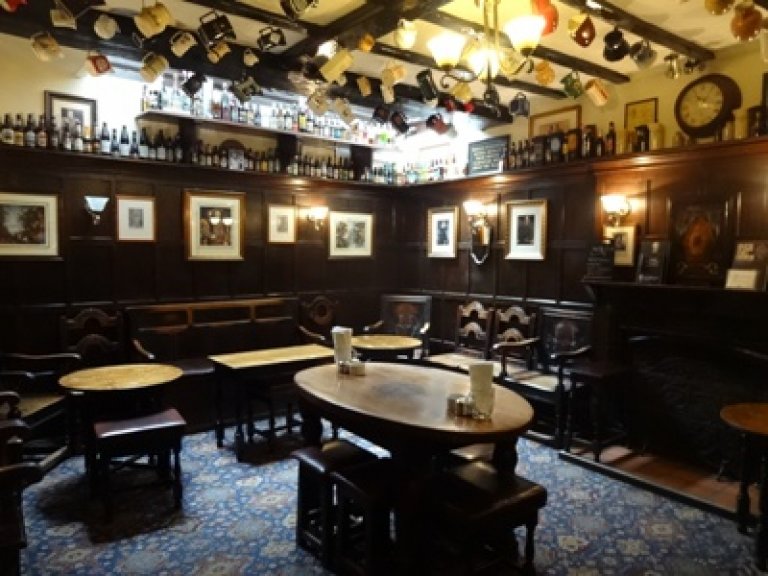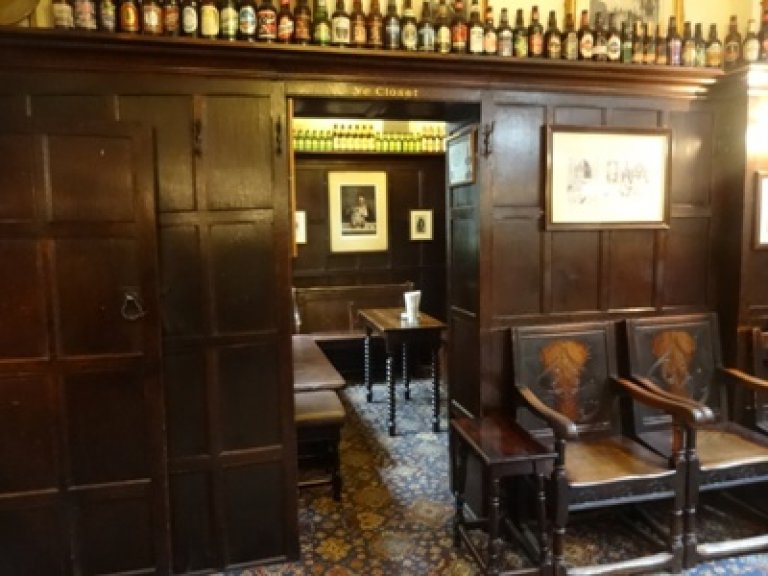Olde Mitre
1 Ely Court,Ely Place,
EC1N 6SJ
This pub is not only a grade II listed building, it is also a Three Star pub on the Campaign for Real Ale’s (CAMRA) National Inventory with an interior of outstanding national historic importance, and the description is as follows: “Finding this vibrant, historic pub in a tiny alley between Hatton Garden and Ely Place is a test of pub-going initiative but success will be rewarded by several regular ales plus a guest. It is said to have been founded in 1546 to minister to the servants of the Bishop of Ely who had his London residence in the vicinity and whose headgear provides the name of the pub. It was rebuilt at the end of the 18th century but, as we see it today, the interior is a remodelling of around 1930 with lots of panelling in the then-fashionable Tudor style. There are two rooms (both called ‘lounge bar’) either side of a central servery, a small, cosy one at the front and a larger one at the back. Off the latter is an intimate little snug, now named ‘Ye Closet’. The upstairs ‘Bishop’s Room’ was fitted out about 1990. The gents’ can only be entered from outside – how rare is that in a London pub? History on the spot: In the late 16th century Elizabeth I obliged the bishop to part with some of the site so her Chancellor, Sir Christopher Hatton, could build himself a fine house. The story goes that the tree trunk in the front bar is the remnant of a cherry tree marking the boundary between Hatton’s property and the bishop’s. Mmm! Hatton House had gone by 1720 and the link with the Diocese of Ely ceased in 1772 when Ely Place passed to the Crown (it is still Crown property and, quirkily, outside the jurisdiction of the City of London).”
The listing description is as follows: “Public house. C1773 with early C20 internal remodelling and late C20 extension at rear. MATERIALS: stock brick. Welsh slate roof. PLAN: front and back bars separated by central servery. Small snug leading off back bar. EXTERIOR: 3 storeys plus attic. Ground floor frontage with glazed timber screen, central window with 18 square lights. Right-hand doorway blocked and framed by flat pilasters with Corinthian capitals. To left blocked doorway or hatch. Entablature with dentil cornice. 2 first floor 6!6 horned sash windows with 2-light casements under cambered heads. Timber and glass front with door to southern part of left-hand return. 2 first floor windows similar to main frontage. 2 blind second floor windows. 2 storey wing on left of building, 3-light Tudor style windows on ground floor. INTERIOR: ground floor bar spaces have extensive panelling, possibly installed in 1920s refitting. Panelled bar counters to front and back bars. Tudor style fireplaces in both bars. Skylight over rear part of rear bar. Corner of the front bar near entrance glazed in to reveal trunk of what is believed to be a cherry tree, marking the boundary of the properties held by the Bishop of Ely and Sir Christopher Hatton. Walls of staircase covered by wide, horizontally laid panels that may date back to late C18 construction. Front upstairs room refitted for public use c1990. HISTORY: The Mitre Tavern believed to be founded in 1546 for the servants at the Bishop of Ely's London house. The site and adjacent properties in Ely Place were cleared after the Crown took over the area in 1772. This public house retains its early C20 plan and fittings almost entirely intact.”
The WhatPub link is here: WhatPub/Olde Mitre
The Pub Heritage Group link is here: PHG/Olde Mitre
Ye Olde Mitre featured on the Evening Crawl of Bloomsbury and Holborn on 4 August 2003, and the Cloth, Meat, Diamonds and Leather: Evening Crawl of Smithfield and Clerkenwell on 13 April 2011.




